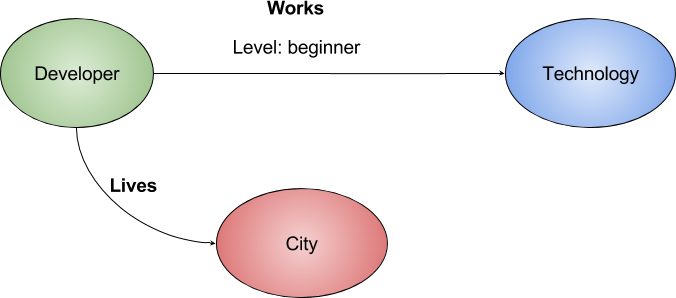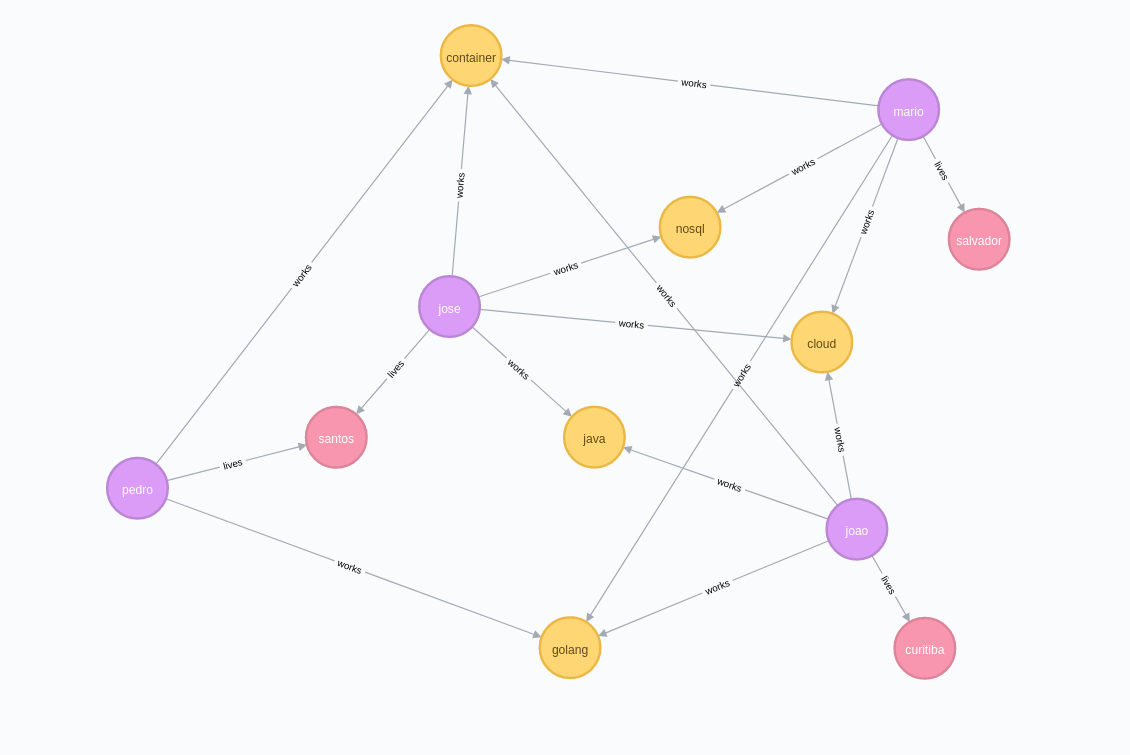Building a Career Recommendation Engine With Neo4j
It's simple to build a career recommendation engine with Neo4j. Learn how to do so based on what technology a developer knows, how advanced they are, and where they live.
Join the DZone community and get the full member experience.
Join For FreeNeo4j is a graph database management system developed by Neo4j. Described by its developers as an ACID-compliant transactional database with native graph storage and processing, Neo4j is the most popular graph database according to DB-Engines rankings. As described before, a graph database is a good solution when you require a relationship with direction, i.e. a recommendation system that takes into consideration the fact that just because you know a famous person that does not mean this person knows you. Beyond the accord direction, each interrelationship has a property that makes this relationship more profound than it would be with a relational database. This article will give a simple example of a recommendation engine with Neo4j.
Install Neo4j With Docker
Install Docker. Run the Docker command:
docker run --publish=7474:7474 --publish=7687:7687 --volume=$HOME/neo4j/data:/data neo4jConfigure Neo4j at http://localhost:7474.
Creating a Career Recommendation
This application makes a career recommendation; given a developer who knows technology at a certain and lives in a certain city, the application returns:
Developers of the technology.
Developers from the town.
Developers of a municipality who know the technique and have a given level of knowledge.
In a relational database, the developer will start with the normalization process so that they can know more than one technology. The same concept happens between city and developer, resulting in a bunch of N to N relationships — even in an uncomplicated recommendation.
In the graph, the model will be easier than with a database once given a developer who works with the technology at a certain level (that will be an edge property). Also, this developer lives in a certain city.

The Dependencies
As usual, the minimum requirement is any Java EE 8 server and Java 8. Beyond this, there is Eclipse JNoSQL mapping, Apache TinkerPop, and the Neo4j driver.
<dependencies>
<dependency>
<groupId>org.jnosql.artemis</groupId>
<artifactId>graph-extension</artifactId>
<version>0.0.4</version>
</dependency>
<dependency>
<groupId>org.jnosql.artemis</groupId>
<artifactId>artemis-configuration</artifactId>
<version>0.0.4</version>
</dependency>
<dependency>
<groupId>org.apache.tinkerpop</groupId>
<artifactId>gremlin-core</artifactId>
<version>${tinkerpop.version}</version>
</dependency>
<dependency>
<groupId>com.steelbridgelabs.oss</groupId>
<artifactId>neo4j-gremlin-bolt</artifactId>
<version>0.2.25</version>
</dependency>
<dependency>
<groupId>org.neo4j.driver</groupId>
<artifactId>neo4j-java-driver</artifactId>
<version>1.4.3</version>
</dependency>
<dependency>
<groupId>javax</groupId>
<artifactId>javaee-api</artifactId>
<version>8.0</version>
<type>jar</type>
<scope>provided</scope>
</dependency>
</dependencies> Eclipse JNoSQL has an integration with Apache Tinkerpop. This is the first step in making an Apache TinkerPop graph available in the CDI container.
public interface GraphSupplier extends Supplier<Graph> {
}@ApplicationScoped
public class GraphProducer {
@Inject
private GraphSupplier graphSupplier;
@Produces
@RequestScoped
public Graph getGraph() {
return graphSupplier.get();
}
public void dispose(@Disposes Graph graph) throws Exception {
graph.close();
}
}The default supplier implementation injects the driver.
@ApplicationScoped
public class DefaultGraphSupplier implements GraphSupplier {
private static final Neo4JElementIdProvider<?> VERTEX_ID_PROVIDER = new Neo4JNativeElementIdProvider();
private static final Neo4JElementIdProvider<?> EDGE_PROVIDER = new Neo4JNativeElementIdProvider();
@Inject
@ConfigurationUnit
private Instance<Driver> driver;
@Override
public Graph get() {
Neo4JGraph graph = new Neo4JGraph(driver.get(), VERTEX_ID_PROVIDER, EDGE_PROVIDER);
graph.setProfilerEnabled(true);
return graph;
}
}META-INF/jnosql.json has a file with the Neo4j configuration.
[
{
"description": "The Neo4J configuration",
"name": "name",
"settings": {
"url": "bolt://localhost:7687",
"admin": "neo4j",
"password": "admin"
}
}
]Modeling
To this clean sample, it will need a sample name and a URL-friendly name. To keep this behavior, there's a Name type.
import java.util.Locale;
import java.util.Objects;
import java.util.function.Supplier;
import static java.text.Normalizer.Form.NFD;
import static java.text.Normalizer.normalize;
import static java.util.Objects.requireNonNull;
public final class Name implements Supplier<String> {
private final String value;
private Name(String value) {
requireNonNull(value, "value is required");
this.value = normalize(value.toLowerCase(Locale.US).replace(" ", "_"), NFD);
}
@Override
public String get() {
return value;
}
@Override
public boolean equals(Object o) {
if (this == o) {
return true;
}
if (!(o instanceof Name)) {
return false;
}
Name name = (Name) o;
return Objects.equals(value, name.value);
}
@Override
public int hashCode() {
return Objects.hashCode(value);
}
@Override
public String toString() {
return value;
}
public static Name of(String name) {
return new Name(name);
}
}@Entity(value = "BUDDY")
public class Buddy implements Serializable {
@Id
private Long id;
@Column
@Convert(NameConverter.class)
private Name name;
@Column
private String displayName;
@Column
private Double salary;
//...
}@Entity(value = "CITY")
public class City implements Serializable {
@Id
private Long id;
@Column
@Convert(NameConverter.class)
private Name name;
@Column
private String displayName;
//...
}@Entity(value = "TECHNOLOGY")
public class Technology implements Serializable {
@Id
private Long id;
@Column
@Convert(NameConverter.class)
private Name name;
@Column
private String displayName;
//...
}In JPA, there is a converter for Name to String with the implementation of AttributeConverter.
public class NameConverter implements AttributeConverter<Name, String> {
@Override
public String convertToDatabaseColumn(Name attribute) {
if (attribute == null) {
return null;
}
return attribute.get();
}
@Override
public Name convertToEntityAttribute(String dbData) {
if (dbData == null) {
return null;
}
return Name.of(dbData);
}
}Repository
There is a repository in the Artemis; we just need to implement the Repository interface. There is a powerful resource called a method query; at this point, we only find and delete from the name.
public interface TechnologyRepository extends Repository<Technology, Long> {
Optional<Technology> findByName(String name);
void deleteByName(String buddyName);
}public interface CityRepository extends Repository<City, Long> {
Optional<City> findByName(String name);
void deleteByName(String buddyName);
}public interface BuddyRepository extends Repository<Buddy, Long> {
Optional<Buddy> findByName(String name);
void deleteByName(String buddyName);
}There is graph traversal that allows a complex query among both vertex and edge. To make that relationship, there is a service to a buddy.
@ApplicationScoped
public class BuddyService {
@Inject
private GraphTemplate graphTemplate;
public List<Buddy> findByTechnology(String technology) throws NullPointerException {
requireNonNull(technology, "technology is required");
Stream<Buddy> buddies = graphTemplate.getTraversalVertex()
.hasLabel(Technology.class)
.has("name", technology)
.in(Edges.WORKS).orderBy("name").asc().stream();
return buddies.collect(Collectors.toList());
}
public List<Buddy> findByTechnology(String technology, TechnologyLevel level) throws NullPointerException {
requireNonNull(technology, "technology is required");
requireNonNull(level, "level is required");
Stream<Buddy> buddies = graphTemplate.getTraversalVertex()
.hasLabel(Technology.class)
.has("name", technology)
.inE(Edges.WORKS).has(TechnologyLevel.EDGE_PROPERTY, level.get())
.outV().orderBy("name").asc().stream();
return buddies.collect(Collectors.toList());
}
public List<Buddy> findByCity(String city) throws NullPointerException {
requireNonNull(city, "city is required");
Stream<Buddy> buddies = graphTemplate.getTraversalVertex()
.hasLabel(City.class)
.has("name", city)
.in(Edges.LIVES)
.orderBy("name").asc().stream();
return buddies.collect(Collectors.toList());
}
public List<Buddy> findByTechnologyAndCity(String technology, String city) throws NullPointerException {
requireNonNull(technology, "technology is required");
requireNonNull(city, "city is required");
Stream<Buddy> buddies = graphTemplate.getTraversalVertex()
.hasLabel(Technology.class)
.has("name", Name.of(technology).get())
.in(Edges.WORKS)
.filter(b -> graphTemplate.getEdges(b, Direction.OUT, Edges.LIVES).stream()
.<City>map(EdgeEntity::getInbound)
.anyMatch(c -> c.equals(city))
).orderBy("name").asc().stream();
return buddies.collect(Collectors.toList());
}
public void live(Buddy buddy, City city) throws NullPointerException{
requireNonNull(buddy, "buddy is required");
requireNonNull(city, "city is required");
graphTemplate.edge(buddy, Edges.LIVES, city);
}
public void work(Buddy buddy, Technology technology) {
requireNonNull(buddy, "buddy is required");
requireNonNull(technology, "technology is required");
graphTemplate.edge(buddy, Edges.WORKS,technology);
}
public void work(Buddy buddy, Technology technology, TechnologyLevel level) {
requireNonNull(buddy, "buddy is required");
requireNonNull(technology, "technology is required");
requireNonNull(level, "level is required");
EdgeEntity edge = graphTemplate.edge(buddy, Edges.WORKS, technology);
edge.add(TechnologyLevel.EDGE_PROPERTY, level.get());
}
}Resource
As the last step in the application, expose this service as a REST API.
@ApplicationScoped
@Path("cities")
@Produces(MediaType.APPLICATION_JSON)
@Consumes(MediaType.APPLICATION_JSON)
@Transactional
public class CityResource {
@Inject
@Database(GRAPH)
private CityRepository cityRepository;
@POST
public void insert(@Name String name) {
cityRepository.findByName(name).ifPresent(b -> {
throw new WebApplicationException("There is city that already does exist", Response.Status.BAD_REQUEST);
});
cityRepository.save(new City(name));
}
@GET
@Path("{name}")
public CityDTO get(@PathParam("name")String name) {
City city = cityRepository.findByName(name)
.orElseThrow(() -> new WebApplicationException("city does not found", Response.Status.NOT_FOUND));
return new CityDTO(city);
}
@DELETE
@Path("{name}")
public void delete(@PathParam("name") @Name String buddyName) {
cityRepository.deleteByName(buddyName);
}
}@ApplicationScoped
@Path("technologies")
@Produces(MediaType.APPLICATION_JSON)
@Consumes(MediaType.APPLICATION_JSON)
@Transactional
public class TechnologyResource {
@Inject
@Database(GRAPH)
private TechnologyRepository cityRepository;
@POST
public void insert(@Name String name) {
cityRepository.findByName(name).ifPresent(b -> {
throw new WebApplicationException("There is a technology that already does exist", Response.Status.BAD_REQUEST);
});
cityRepository.save(new Technology(name));
}
@GET
@Path("{name}")
public TechnologyDTO get(@PathParam("name")String name) {
Technology technology = cityRepository.findByName(name)
.orElseThrow(() -> new WebApplicationException("technology does not found", Response.Status.NOT_FOUND));
return new TechnologyDTO(technology);
}
@DELETE
@Path("{name}")
public void delete(@PathParam("name") @Name String buddyName) {
cityRepository.deleteByName(buddyName);
}
}@ApplicationScoped
@Path("buddies")
@Produces(MediaType.APPLICATION_JSON)
@Consumes(MediaType.APPLICATION_JSON)
@Transactional
public class BuddyResource {
@Inject
@Database(GRAPH)
private BuddyRepository buddyRepository;
@Inject
@Database(GRAPH)
private CityRepository cityRepository;
@Inject
@Database(GRAPH)
private TechnologyRepository technologyRepository;
@Inject
private BuddyService service;
@POST
public void insert(@Valid BuddyDTO buddy) {
buddyRepository.findByName(buddy.getName()).ifPresent(b -> {
throw new WebApplicationException("There is a buddy that already does exist", Response.Status.BAD_REQUEST);
});
buddyRepository.save(buddy.toEnity());
}
@GET
@Path("{buddy}")
public BuddyDTO get(@PathParam("buddy") @Name String buddyName) {
Buddy buddy = buddyRepository.findByName(buddyName)
.orElseThrow(() -> new WebApplicationException("buddy does not found", Response.Status.NOT_FOUND));
return BuddyDTO.of(buddy);
}
@GET
@Path("cities/{city}")
public List<BuddyDTO> getCities(@PathParam("city") @Name String city) {
return service.findByCity(city).stream().map(BuddyDTO::of).collect(toList());
}
@GET
@Path("technologies/{technology}")
public List<BuddyDTO> getTechnologies(@PathParam("technology") @Name String technology) {
return service.findByTechnology(technology).stream().map(BuddyDTO::of).collect(toList());
}
@GET
@Path("technologies/{technology}/{level}")
public List<BuddyDTO> getTechnologiesLevel(@PathParam("technology") @Name String technology,
@PathParam("level") String level) {
return service.findByTechnology(technology, TechnologyLevel.parse(level)).stream().map(BuddyDTO::of).collect(toList());
}
@GET
@Path("cities/{city}/technologies/{technology}")
public List<BuddyDTO> getCitiesTechnologies(@PathParam("city") @Name String city,
@PathParam("technology") @Name String technology) {
return service.findByTechnologyAndCity(technology, city).stream().map(BuddyDTO::of).collect(toList());
}
@PUT
@Path("{buddy}")
public void update(@PathParam("buddy") @Name String buddyName, @Valid BuddyDTO dto) {
Buddy buddy = buddyRepository.findByName(buddyName)
.orElseThrow(() -> new WebApplicationException("buddy does not found", Response.Status.NOT_FOUND));
buddy.setSalary(dto.getSalary());
buddyRepository.save(buddy);
}
@DELETE
@Path("{buddy}")
public void delete(@PathParam("buddy") @Name String buddyName) {
buddyRepository.deleteByName(buddyName);
}
@PUT
@Path("{buddy}/lives/{city}")
public void lives(@PathParam("buddy") @Name String buddyName, @PathParam("city") @Name String cityName) {
Buddy buddy = buddyRepository.findByName(buddyName)
.orElseThrow(() -> new WebApplicationException("buddy does not found", Response.Status.NOT_FOUND));
City city = cityRepository.findByName(cityName)
.orElseThrow(() -> new WebApplicationException("city does not found", Response.Status.NOT_FOUND));
service.live(buddy, city);
}
@PUT
@Path("{buddy}/works/{technology}")
public void works(@PathParam("buddy") @Name String buddyName, @PathParam("technology") @Name String technologyName) {
Buddy buddy = buddyRepository.findByName(buddyName)
.orElseThrow(() -> new WebApplicationException("buddy does not found", Response.Status.NOT_FOUND));
Technology technology = technologyRepository.findByName(technologyName)
.orElseThrow(() -> new WebApplicationException("city does not found", Response.Status.NOT_FOUND));
service.work(buddy, technology);
}
@PUT
@Path("{buddy}/works/{technology}/{level}")
public void worksLevel(@PathParam("buddy") @Name String buddyName,
@PathParam("technology") @Name String technologyName,
@PathParam("level") String level) {
Buddy buddy = buddyRepository.findByName(buddyName)
.orElseThrow(() -> new WebApplicationException("buddy does not found", Response.Status.NOT_FOUND));
Technology technology = technologyRepository.findByName(technologyName)
.orElseThrow(() -> new WebApplicationException("city does not found", Response.Status.NOT_FOUND));
service.work(buddy, technology, TechnologyLevel.parse(level));
}
}The new @Transactional annotation is a CDI interceptor that makes any resource operation transactional.
Time to Test
With the code ready and the system running on a Java EE 8 server, the next step is to run and test it.
#cities
curl -H "Content-Type: application/json" -X POST -d 'Santos' http://localhost:8080/careerbuddy/resource/cities/
curl -H "Content-Type: application/json" -X POST -d 'Salvador' http://localhost:8080/careerbuddy/resource/cities/
curl -H "Content-Type: application/json" -X POST -d 'Belo Horizonte' http://localhost:8080/careerbuddy/resource/cities/
curl -H "Content-Type: application/json" -X POST -d 'Rio de Janeiro' http://localhost:8080/careerbuddy/resource/cities/
curl -H "Content-Type: application/json" -X POST -d 'Curitiba' http://localhost:8080/careerbuddy/resource/cities/
#technologies
curl -H "Content-Type: application/json" -X POST -d 'Java' http://localhost:8080/careerbuddy/resource/technologies/
curl -H "Content-Type: application/json" -X POST -d 'NoSQL' http://localhost:8080/careerbuddy/resource/technologies/
curl -H "Content-Type: application/json" -X POST -d 'Cloud' http://localhost:8080/careerbuddy/resource/technologies/
curl -H "Content-Type: application/json" -X POST -d 'Container' http://localhost:8080/careerbuddy/resource/technologies/
curl -H "Content-Type: application/json" -X POST -d 'Golang' http://localhost:8080/careerbuddy/resource/technologies/
#buddies
curl -H "Content-Type: application/json" -X POST -d '{"name":"Jose","salary":3000.0}' http://localhost:8080/careerbuddy/resource/buddies/
curl -H "Content-Type: application/json" -X POST -d '{"name":"Mario","salary":5000.0}' http://localhost:8080/careerbuddy/resource/buddies/
curl -H "Content-Type: application/json" -X POST -d '{"name":"Joao","salary":9000.0}' http://localhost:8080/careerbuddy/resource/buddies/
curl -H "Content-Type: application/json" -X POST -d '{"name":"Pedro","salary":14000.0}' http://localhost:8080/careerbuddy/resource/buddies/
#lives
curl -H "Content-Type: application/json" -X PUT http://localhost:8080/careerbuddy/resource/buddies/mario/lives/salvador
curl -H "Content-Type: application/json" -X PUT http://localhost:8080/careerbuddy/resource/buddies/joao/lives/curitiba
curl -H "Content-Type: application/json" -X PUT http://localhost:8080/careerbuddy/resource/buddies/pedro/lives/santos
curl -H "Content-Type: application/json" -X PUT http://localhost:8080/careerbuddy/resource/buddies/jose/lives/santos
#works
curl -H "Content-Type: application/json" -X PUT http://localhost:8080/careerbuddy/resource/buddies/jose/works/java/advanced
curl -H "Content-Type: application/json" -X PUT http://localhost:8080/careerbuddy/resource/buddies/jose/works/nosql/beginner
curl -H "Content-Type: application/json" -X PUT http://localhost:8080/careerbuddy/resource/buddies/jose/works/cloud/intermediate
curl -H "Content-Type: application/json" -X PUT http://localhost:8080/careerbuddy/resource/buddies/jose/works/container/advanced
curl -H "Content-Type: application/json" -X PUT http://localhost:8080/careerbuddy/resource/buddies/mario/works/golang/advanced
curl -H "Content-Type: application/json" -X PUT http://localhost:8080/careerbuddy/resource/buddies/mario/works/nosql/advanced
curl -H "Content-Type: application/json" -X PUT http://localhost:8080/careerbuddy/resource/buddies/mario/works/cloud/beginner
curl -H "Content-Type: application/json" -X PUT http://localhost:8080/careerbuddy/resource/buddies/mario/works/container/beginner
curl -H "Content-Type: application/json" -X PUT http://localhost:8080/careerbuddy/resource/buddies/joao/works/java/intermediate
curl -H "Content-Type: application/json" -X PUT http://localhost:8080/careerbuddy/resource/buddies/joao/works/cloud/advanced
curl -H "Content-Type: application/json" -X PUT http://localhost:8080/careerbuddy/resource/buddies/joao/works/container/advanced
curl -H "Content-Type: application/json" -X PUT http://localhost:8080/careerbuddy/resource/buddies/joao/works/golang/beginner
curl -H "Content-Type: application/json" -X PUT http://localhost:8080/careerbuddy/resource/buddies/pedro/works/golang/beginner
curl -H "Content-Type: application/json" -X PUT http://localhost:8080/careerbuddy/resource/buddies/pedro/works/container/advanced
Query result:
curl http://localhost:8080/careerbuddy/resource/buddies/technologies/java
curl http://localhost:8080/careerbuddy/resource/buddies/technologies/cloud
curl http://localhost:8080/careerbuddy/resource/buddies/technologies/java/advanced
curl http://localhost:8080/careerbuddy/resource/buddies/cities/salvador
curl http://localhost:8080/careerbuddy/resource/buddies/cities/santos/technologies/javaReferences
Opinions expressed by DZone contributors are their own.

Comments